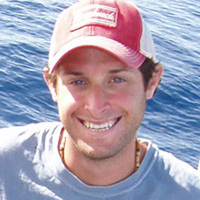Shane Gero
Aarhus University, Bioscience, Post-Doc
Research Interests:
Observed rates of increase calculated from trends in the numbers of animals present in a population should generally agree with those estimated from life-history data. However, for a small population of individually identified sperm... more
Observed rates of increase calculated from trends in the numbers of animals present in a population should generally agree with those estimated from life-history data. However, for a small population of individually identified sperm whales
Physeter macrocephalus occupying the waters of the eastern Caribbean there is a discrepancy. Using a mark-recapture analysis that included heterogeneity in identification, the population, numbering about 156 adults (95% CI 126−195) in 1998, has been increasing at 3.4% yr−1 (95% CI: 1.0−5.7% yr−1). However, a 2-stage matrix population model including unweaned calves and adults (and excluding mature males), whose parameters were estimated directly from empirical data, gave a projected rate of increase of −2.7% yr−1 (95% CI: −5.4 to −0.4% yr−1). This estimate is primarily sensitive to calculated adult mortality. The discrepancy between the observed and projected rates of increase for this population may be explained by a high, probably anthropogenic, mortality of sperm whales in the eastern Caribbean, coupled with immigration from surrounding regions, so the area becomes an
attractive sink (ecological trap). The analysis emphasizes the fragility of sperm whale populations. More generally, our analysis of this population shows that a positive observed rate of increase is not necessarily a sign of a healthy population. This case study highlights the importance of analysing populations of endangered species using multiple methodologies and with a solid base of individual-level empirical data based on longitudinal monitoring.
Physeter macrocephalus occupying the waters of the eastern Caribbean there is a discrepancy. Using a mark-recapture analysis that included heterogeneity in identification, the population, numbering about 156 adults (95% CI 126−195) in 1998, has been increasing at 3.4% yr−1 (95% CI: 1.0−5.7% yr−1). However, a 2-stage matrix population model including unweaned calves and adults (and excluding mature males), whose parameters were estimated directly from empirical data, gave a projected rate of increase of −2.7% yr−1 (95% CI: −5.4 to −0.4% yr−1). This estimate is primarily sensitive to calculated adult mortality. The discrepancy between the observed and projected rates of increase for this population may be explained by a high, probably anthropogenic, mortality of sperm whales in the eastern Caribbean, coupled with immigration from surrounding regions, so the area becomes an
attractive sink (ecological trap). The analysis emphasizes the fragility of sperm whale populations. More generally, our analysis of this population shows that a positive observed rate of increase is not necessarily a sign of a healthy population. This case study highlights the importance of analysing populations of endangered species using multiple methodologies and with a solid base of individual-level empirical data based on longitudinal monitoring.
Research Interests:
The number of contributing reviewers often outnumbers the authors of publications. This has led to apathy towards reviewing and the conclusion that the peer-review system is broken. Given the trade-offs between submitting and reviewing... more
The number of contributing reviewers often outnumbers the authors of publications. This has led to apathy towards reviewing and the conclusion that the peer-review system is broken. Given the trade-offs between submitting and reviewing manuscripts, reviewers and authors naturally want visibility for their efforts. While study after study has called for revolutionizing publication practices, the current paradigm does not recognize reviewers' time and expertise. We propose the R-index as a simple way to quantify scientists' contributions as reviewers. We modelled its performance using simulations based on real data to show that early-mid career scientists, who complete high-quality reviews of longer manuscripts within their field, can perform as well as leading scientists reviewing only for high-impact journals. By giving citeable academic recognition for reviewing, R-index will encourage more participation with better reviews, regardless of the career stage. Moreover, the R-i...
Research Interests:
Research Interests:
Research Interests:
Research Interests:
Research Interests:
Research Interests:
Research Interests:
Research Interests:
Research Interests:
Research Interests:
Research Interests:
While large scale surveys would provide more accurate data on distribution and abundance, the pooling of opportunistic sightings data from a multitude of projects provides a relatively economical way of achieving a large data set over a... more
While large scale surveys would provide more accurate data on distribution and abundance, the pooling of opportunistic sightings data from a multitude of projects provides a relatively economical way of achieving a large data set over a multinational area such as the Caribbean Sea. Here, we provide details of the opportunistic small cetacean sightings made in the national waters of
